Exploring Perceptions of Vitamin D Awareness among Clinicians in Local Health Facilities of Pakistan: A Mixed - Method Study
DOI:
https://doi.org/10.36570/jduhs.2025.2.2392Keywords:
25-hydroxy vitamin D, Awareness, Care providers, perception, Qualitative, health practicesAbstract
Objective: To assess the knowledge, attitudes, and practices regarding vitamin D among clinicians in local health facilities of Pakistan, and to explore their perceptions through a mixed-method approach.
Methods: This mixed-methods study was conducted in local health facilities of Karachi and Multan, from June to September 2024. Clinicians holding MBBS and BDS degrees involved in patient care were included. Quantitative data were collected using the validated Vitamin D Knowledge, Attitude, and Practice questionnaire (D-KAP-38), consisting of 38 items across four domains. Higher mean scores indicated better knowledge, more positive attitudes, and healthier practices related to vitamin D. Qualitative data were gathered through five focus group discussions with 20 clinicians and analyzed using manual thematic analysis.
Results: A total of 278 clinicians, the mean age was 30.7 ± 5.1 years. Overall, mean scores of general knowledge 18.39 ±2.91, nutritional knowledge 4.93 ±2.39, attitude 48.61 ±7.49, and practice 30.19 ±4.08, indicating high general knowledge, moderately positive attitudes and practices, but relatively low nutritional knowledge. Female clinicians demonstrated significantly higher nutritional knowledge (p-value =0.016) and healthier practice behaviors (p-value <0.001). MBBS graduates had higher practice scores than BDS (p-value =0.038). Clinicians over 30 years scored higher in nutritional knowledge (p-value =0.010) and attitude (p-value <0.001). Qualitative analysis identified four themes: vitamin D's broader health role, barriers to testing, challenges in prescribing, and recommendations including continuing medical education, public education, and policy support.
Conclusion: Clinicians showed good awareness, but gaps in nutrition knowledge and practice highlight the need for targeted education and policy support.
Downloads
References
Sizar O, Khare S, Goyal A, Givler A. Vitamin D deficiency [Internet]. Treasure Island (FL): StatPearls Publishing; 2024 [updated 2023 Jul 17; cited 2024 Apr 18]. Available from: https://www.ncbi.nlm.nih.gov/books/NBK279072/
Iqbal R, Khan AH. Possible causes of vitamin D deficiency (VDD) in Pakistani population residing in Pakistan. J Pak Med Assoc 2010; 60:1-2.
Roth DE, Abrams SA, Aloia J, Bergeron G, Bourassa MW, Brown KH, et al. Global prevalence and disease burden of vitamin D deficiency: a roadmap for action in low‐ and middle‐income countries. Ann N Y Acad Sci 2018; 1424:44-57. doi:10.1111/nyas.13968
Tariq A, Khan SR, Basharat A. Assessment of knowledge, attitudes and practice towards Vitamin D among university students in Pakistan. BMC Public Health 2020; 20:355. doi:10.1186/s12889-020-8453-y
Ali N. Role of vitamin D in preventing COVID-19 infection, progression, and severity. J Infect Public Health 2020; 13:1373-80. doi:10.1016/j.jiph.2020.06.021.
AbdulRahman KA, Aljasser KA, Al-Kabi AA, Alramadhan ZT, Alhussaini JT, Almutairi AM, et al. Assessment of knowledge and awareness of vitamin D deficiency among medical students in Saudi Arabia: A cross-sectional study. Med Sci 2023; 27:e23ms2735. doi:10.54905/disssi/v27i131/e23ms2735
National Institutes of Health. Vitamin D fact sheet for health professionals [Internet]. Bethesda (MD): U.S. Department of Health and Human Services; 2020 [cited 2024 Apr 18]. Available from: https://ods.od.nih. gov/factsheets/VitaminD-HealthProfessional/.
Zhao S, Qian F, Wan Z, Chen X, Pan A, Liu G. Vitamin D and major chronic diseases. Trends Endocrinol Metab 2024; 35:172-84. doi:10.1016/j.tem.2024.04.018
Biasucci G, Donini V, Cannalire G. Rickets types and treatment with vitamin D and analogues. Nutrients 2024; 16:416. doi:10.3390/nu16030416
Farhangnia P, Noormohammadi M, Delbandi A-A. Vita-min D and reproductive disorders: a comprehensive review with a focus on endometriosis. Reprod Health 2024; 21:61. doi:10.1186/s12978-024-01797-y
Vassalle C. Vitamin D: from pathophysiology to clinical impact. Front Endocrinol (Lausanne) 2024; 15:1506137. doi:10.3389/fnut.2024.1506137.
Siddiqee MH, Bhattacharjee B, Siddiqi UR, MeshbahurRahman M. High prevalence of vitamin D deficiency among South Asian adults: a systematic review and meta-analysis. BMC Public Health 2021; 21:1823. doi:10.1186/s12889-021-11888-1
. Mahmood Y, Waris N, Fawwad A, Basit A. Vitamin D deficiency and diseases: a review from Pakistan. J Diabetol 2021; 12:391-400. doi:10.4103/jod.jod_32_21
Juanid R, Feroz S, Mughal A. Knowledge, attitude and practice of medical students regarding vitamin D. J Rawalpindi Med Coll 2019; 23:12-8.
Alamoudi LH, Almuteeri RZ, Al-Otaibi ME, Alshaer DA, Fatani SK, Alghamdi MM, et al. Awareness of vitamin D deficiency among the general population in Jeddah, Saudi Arabia. J Nutr Metab 2019; 2019:4138187. doi:10.1155/2019/4138187
Lhamo Y, Chugh PK, Gautam SR, Tripathi C. Epidemic of Vitamin D deficiency and its management: awareness among Indian medical undergraduates. J Environ Public Health 2017; 2017:2517207. doi:10.1155/2017/2517207
Kotta S, Gadhvi D, Jakewys N, Saeed M, Sohanpal R, Hull S,et al. “Test me and treat me”-attitudes to vitamin D deficiency and supplementation: a qualitative study. BMJ Open 2015; 5:e007401. doi:10.1136/bmjopen-2014-007401
Bhattarai R, Joshi AR, Pokhrel A, Khanal M, Poudel MP. Assessment of knowledge, attitude and practice regarding vitamin D among medical and dental students of a medical college in Kathmandu. Nepal Med Coll J 2024; 26:125-31. doi:10.3126/nmcj.v26i2.67200
Bonnici M, Buttigieg S, Abdilla S, Ferry P. Vitamin D in the older population: A study of Maltese doctors' knowledge and management. Malta Med J 2020; 32:44-55.
Elghazaly A, Widyan A, Alsahali S, Alshammari M, Farooqui M, Alsaloom D, et al. Knowledge, attitudes, and practices (KAP) of medical university students towards vitamin D deficiency in Saudi Arabia: a cross-sectional study. J Pharm Policy Pract 2024; 17:2381699. doi: 10.1080/20523211.2024.2381699.
Hofstede H, Van HD, Mulder B, Bohnen A, Bindels P, De Wit N, et al. Reducing unnecessary vitamin D testing in general practice: barriers and facilitators according to general practitioners and patients. BMJ Open 2019; 9:e029760. doi:10.1136/bmjopen-2019-029760
Published
How to Cite
Issue
Section
License
Copyright (c) 2025 Asma Akhtar, Sobia Nasir, Wali Muhammad, Rabiya Masood, Shireen Mansoor, Saima Masoom Ali

This work is licensed under a Creative Commons Attribution-NonCommercial 4.0 International License.
Articles published in the Journal of Dow University of Health Sciences are distributed under the terms of the Creative Commons Attribution Non-Commercial License https://creativecommons.org/ licenses/by-nc/4.0/. This license permits use, distribution and reproduction in any medium; provided the original work is properly cited and initial publication in this journal. ![]()





